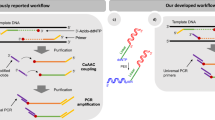Abstract
We have developed an automated DNA sequenator using a real-time fluorescence detection method, and achieved excellent sensitivity and rapid analysis by optimizing operating conditions. The sequenator uses unicolor labeling and four-track electrophoresis. Fluoresceine isothiocyanate(FITC)-labeled primers are used to produce labeled DNA families. The fluorescent bands are excited by an Ar laser (488 nm, 10 mW) introduced from the side of a thin gel during electrophoresis. Analysis, with an accuracy greater than 99%, consumes 0.01–0.04 picomole sample for each DNA family, which is almost comparable to the amount used in conventional autoradiography. With the optimized electrophoresis conditions reported here, four hundred bases of DNA can be analyzed within two and a half hours using a four percent polyacrylamide gel.
This is a preview of subscription content, access via your institution
Access options
Subscribe to this journal
Receive 12 print issues and online access
$209.00 per year
only $17.42 per issue
Buy this article
- Purchase on Springer Link
- Instant access to full article PDF
Prices may be subject to local taxes which are calculated during checkout
Similar content being viewed by others
References
Sanger, F., Niklen, S., and Coulson, A.R. 1977. DNA sequencing with chain-terminating inhibitors. Proc. Natl. Acad. Sci. USA 74:5463–5467.
Maxam, A.M. and Gilbert, W. 1980. Sequencing end-label DNA with base-specific chemical cleavage. Methods Enzymol. 65:499–560.
Wada, A. 1987. Automated high-speed DNA sequencing. Nature 325:771–772.
Martin, W.J. and Davies, R.W. 1986. Automated DNA sequencing: Progress and prospects. Bio Technology 4:890–895.
Martin, W.J. and Davies, R.W. 1986. Automation of DNA sequencing: A system to perform the Sanger dideoxysequencing reactions. Bio Technology 3:911–915.
Hayashibara Forum 1987. Proceeding of an international workshop on automatic and high speed DNA-base sequencing. Okayama, Japan.
Smith, L.M., Sanders, J.Z., Kaiser, R.J., Hughes, P., Dodd, C., Connell, C.R., Heiner, C., Kent, S.B.H., and Hood, L.E. 1986. Fluorescence detection in automated DNA sequence analysis. Nature 321:674–679.
Ansorge, W., Sproat, B.S., Stegemann, J. and Schwager, C. 1986. A non-radioactive automated method for DNA sequencing determination.J. Biochem. Biophys. Methods 13:315–323.
Prober, J.M., Trainor, G.L., Dam, R.J., Hobbs, F.W., Robertson, C.W., Zagursky, R.J., Cocuzza, A.J., Jensen, M.A., and Baumeister, K. 1987. A system for rapid DNA sequencing with fluorescent chain-terminating dideoxynucleotides. Science 238:336–341.
Nagai, K., Shimada, T., Tokita, J., Watanabe, K., Nakano, R., and Kambara, H. 1987. Automation of DNA sequencing. β-ray direct detection method. 38th Pittsburgh Conference, Paper ♯545, Atlantic City, N.J.
Yuki Gosei Kogyo, Ltd. 1986.Fluorophore labeling method for polydeoxyribonucleotide or poly-ribonucleotide. Japan Patent 61/44352, 61/44353.
Author information
Authors and Affiliations
Rights and permissions
About this article
Cite this article
Kambara, H., Nishikawa, T., Katayama, Y. et al. Optimization of Parameters in a DNA Sequenator Using Fluorescence Detection. Nat Biotechnol 6, 816–821 (1988). https://doi.org/10.1038/nbt0788-816
Received:
Accepted:
Issue Date:
DOI: https://doi.org/10.1038/nbt0788-816



